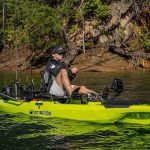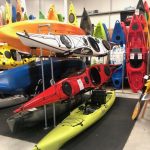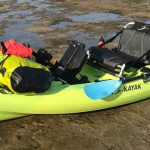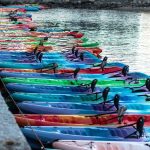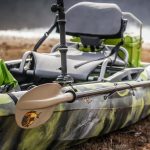In this article, we’ve got all the information you need to decide on the optimal kayak size. Discuss kayak sizes like a pro!
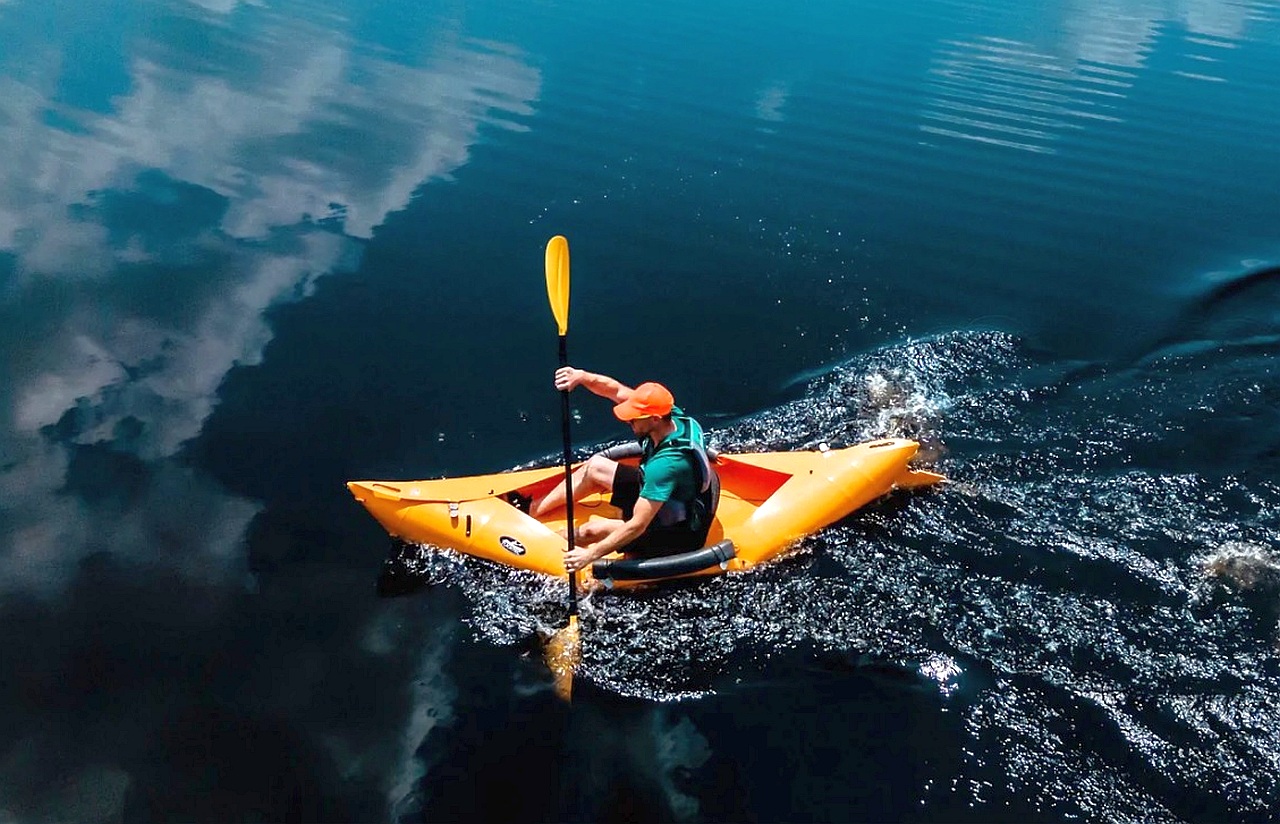
In a hurry? Our pick as the best overall folding kayak is ORU Kayak Beach LT
The one biggest downside about standard kayaks is that they tend to be big, bulky, and heavy—aka, a pain in the neck to transport.
To carry them, you’ve got to have a vehicle with rails to accommodate a roof rack or a hitch to connect a kayak trailer.
Then, you’ve got to load the heavy things onto the rack or trailer, then do all the work of unloading them when you arrive at your destination, only to repeat it again when you’re done paddling.
Add to that all the space they take up in your garage or shed, and you can see why a kayak can be a bit of a hassle sometimes.
That was until the folding kayak had been invented…
The folding kayak is an absolutely brilliant piece of kayak engineering, one that uses sturdy materials but features a design that allows you to fold the kayak up small enough you can carry it in the trunk of your car or the back of your van.
You won’t need a heavy trailer or a roof rack to transport the kayak, and you’ll take up far less space in your garage when storing them.
They’re a total game-changer, which is why we’ve dedicated this entire post to sharing with you everything you need to know about folding kayaks—what they are, the pros and cons, what materials they use, and the crucial factors to consider.
Plus, we’ve got a list of the best folding kayaks on the market for you!
As an affiliate of Amazon and other retailers, we may earn a small commission when you buy via our links, at no additional cost to you. Thank you!
Quick Answer: The Best Folding Kayak for You
- Best Overall: ORU Kayak Beach LT
- Most Versatile: TRAK 2.0 Kayak
- Best Recreational: ORU Kayak Bay ST
- Best for Kayak Fishing: PIKE Kayak
- Best Tandem: ORU Kayak Haven TT
- Fastest: ORU Kayak Coast XT
- Most Portable: PAKAYAK Bluefin 142
- Best Budget: TUCKTEC Folding Kayak
Comparison Table: Best Folding Kayaks
| Model | Specs | Where To Buy |
 ORU Kayak Beach LT | Size: 12’1″ x 29″ Weight: 25 lbs Capacity: 300 lbs | Amazon |
 TRAK 2.0 Kayak | Size: 16’x 22.5″ Weight: 44 lbs Capacity: 350 lbs | TRAK Kayaks |
 ORU Kayak Bay ST | Size: 12’3″ x 25″ Weight: 26 lbs Capacity: 300 lbs | Amazon |
 PIKE Kayak | Size: 10’11” x 32″ Weight: 42 lbs. Capacity: 350 lbs | PIKE Kayak |
 ORU Kayak Haven TT | Size: 16’1″ x 33″ Weight: 41 lbs Capacity: 500 lbs | Amazon |
ORU Kayak Coast XT | Size: 16’2″x 25″ Weight: 32 lbs Capacity: 400 lbs | Amazon |
 PAKAYAK Bluefin 142 | Size: 14’2″ x 24″ Weight: 59 lbs Capacity: 300 lbs | PAKAYAK |
 TUCKTEC Folding Kayak | Size: 9’8″ x 31″ Weight: 28 lbs Capacity: 300 lbs | TUCKTEC |
Best Folding Kayak Reviews
Best Overall: ORU Kayak Beach LT
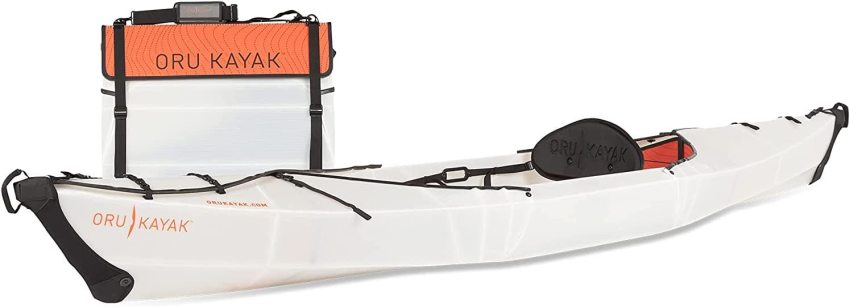
Length: 12’1″ (368 cm)
Beam Width: 29″ (73.7 cm)
Weight: 25 lbs. (11.3 kg)
Weight Capacity: 300 lbs. (136 kg)
Planning to hit up a lake or paddle down a slow-moving river? Then you’ll love ORU Kayak’s Beach LT, a kayak designed to be comfortable, versatile, and stable enough for even newbies.
The kayak features an open cockpit design that’s ideal for taller users, though its weight capacity isn’t the best for heavier paddlers. The adjustable footrest and backrest allow you to tailor the cockpit for your comfort.
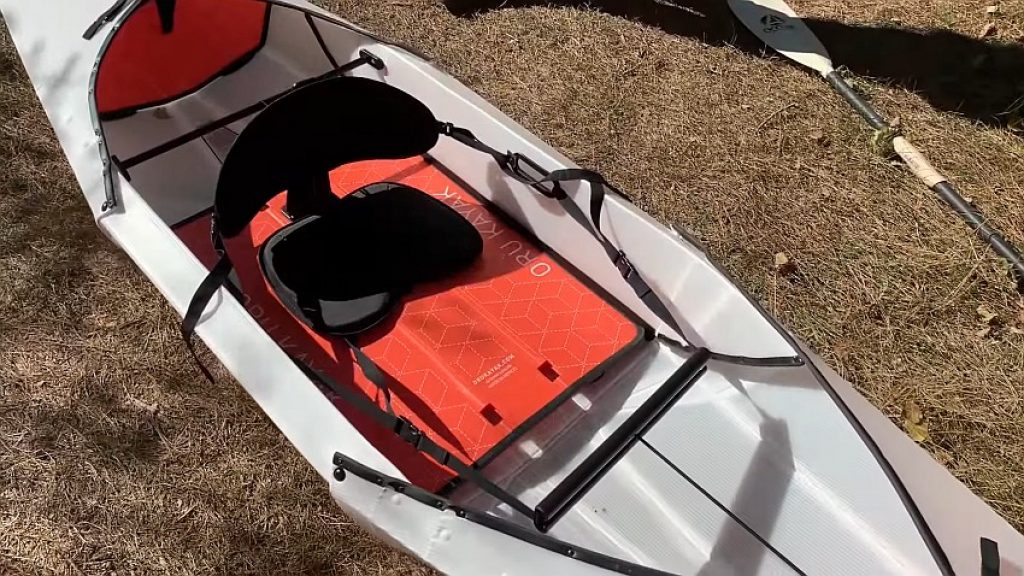
As with all the ORU Kayaks, assembly time is between 5 and 10 minutes—incredibly easy once you get the hang of the process.
What makes ORU such a great brand is the corrugated plastic used for the hulls. Not only is it incredibly sturdy (rated for 20,000 fold cycles), but it’s multi-layered to offer increased abrasion and puncture resistance. It also has better-than-average buoyancy and even features integrated UV protection that keeps the plastic from degrading.
Other convenient features include:
- fairing handles that make hauling it solo or with a friend easy,
- a buckle-closure system that makes assembly a breeze,
- a tension strap to keep the cockpit sturdy and stable,
- excellent waterproofing that ensures you never have to worry about water leaking it.
For newbies or anyone who wants high primary stability, this is the best foldable kayak for you.
Most Versatile: TRAK 2.0 Kayak
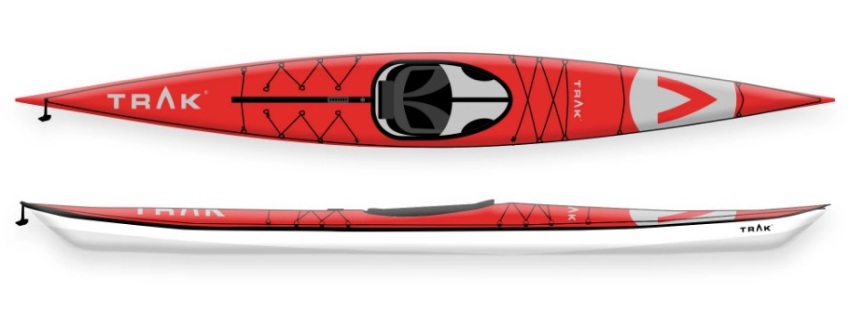
Length: 16′ (487.6 cm)
Beam Width: 22.5″ (57.2 cm)
Weight: 44 lbs. (19.96 kg)
Weight Capacity: 350 lbs. (158.8 kg)
For those who want a touring kayak that’s foldable and portable, TRAK Kayaks’ 2.0 is a game-changer. 16 feet long, with an enclosed cockpit ideal for keeping out sea water, and with a beam width of 22.5 inches, it’s the perfect kayak for slicing through waves and paddling through even the most vicious rip-tides.
At 53 pounds, it’s definitely on the heavier side for a foldable kayak, but it’s capable of holding up to 350 pounds and handles as well as a standard hard-shell touring kayak.
Assembly time is roughly 10 minutes and requires no tools, and the instructions are clear enough that anyone can follow them. Just in case you’re worried about carrying it on the train or bus, you’ll be glad to know the travel bag comes with wheels that make it easy to haul anywhere you go.
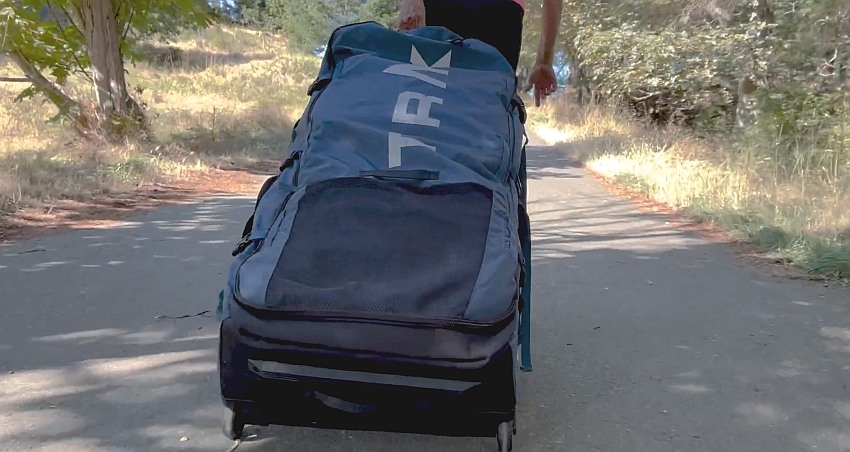
The kayak, like all of TRAK’s models, is backed by a 5-year warranty, and though it’s definitely the priciest on our list, it’s a kayak well worth considering for ocean voyages and long-haul sea travel.
Best Recreational: ORU Kayak Bay ST
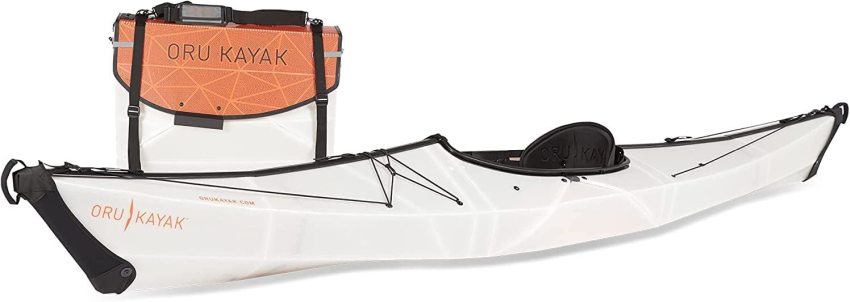
Length: 12’3″ (373.4 cm)
Beam Width: 25″ (63.5 cm)
Weight: 26 lbs. (11.8 kg)
Weight Capacity: 300 lbs. (136 kg)
Quick, speedy, and agile: that’s what makes ORU Kayaks’ Bay ST one of the top-rated folding kayaks on the market. Though it’s built with higher secondary stability than primary stability, that makes it well-suited to handling both ocean waters and fast-flowing rivers. It’ll also handle well on a large-sized lake with high winds and strong currents—it’s built for more experienced kayakers who know how to handle themselves on the open water.
The enclosed cockpit is definitely on the small size for very large paddlers (like me), but the 300-pound weight capacity means it can handle even heavier people. Though it’s a little over 12 feet long, it’s surprisingly lightweight at just 26 pounds—literally anyone can carry it to and from the water. When packed, it fits into the size of a small suitcase. It comes with a shoulder strap that makes carrying it a breeze.
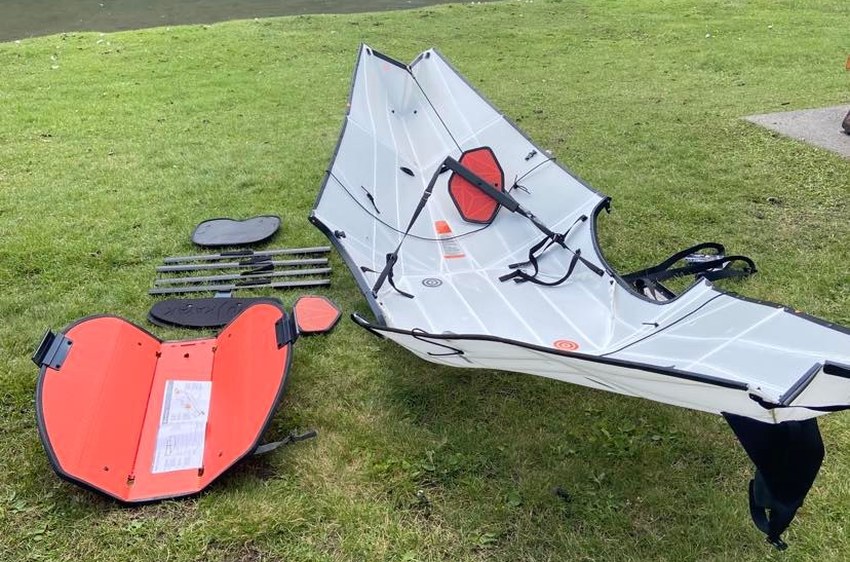
Setup time is under 10 minutes, and that includes adding on the spray skirt and getting it into the water. It’s a user-friendly folding kayak that will make any lake, river, or seaside trip an absolute delight.
Best for Kayak Fishing: PIKE Kayak
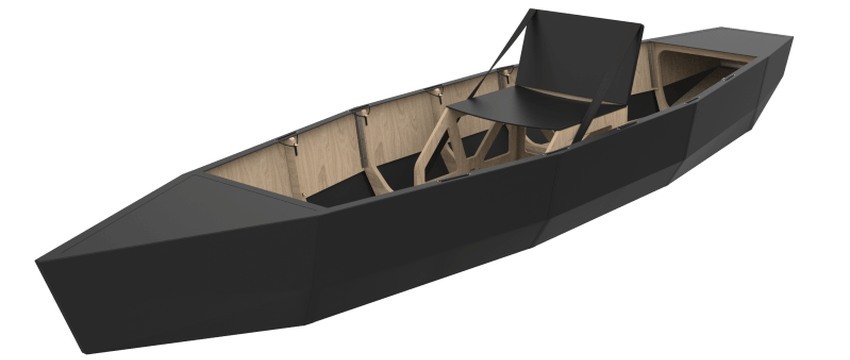
Length: 10’11” (332.7 cm)
Beam Width: 32″ (81.3 cm)
Weight: 42 lbs. (19 kg)
Weight Capacity: 350 lbs. (158.8 kg)
Anglers, this one’s for you! The PIKE Kayak is a folding kayak designed specifically for fishing on lakes and rivers, complete with excellent primary stability, a high stadium seat, and a wide standing platform that lets you fish standing up and sitting down. Plus, the open deck and spacious room at the stern make it easy to store all your fishing gear (bait boxes, tackle boxes, cooler, etc.), and can even accommodate a small child or active pet.
Price-wise, this is one of the more affordable options on our list, but don’t think for a minute that compromises its quality. It’s still built tough and sturdy enough to handle choppy, windy conditions. Thanks to its origami folding design, you can get it assembled or disassembled in less than 5 minutes—just five simple steps you’ll easily master on the first or second try.
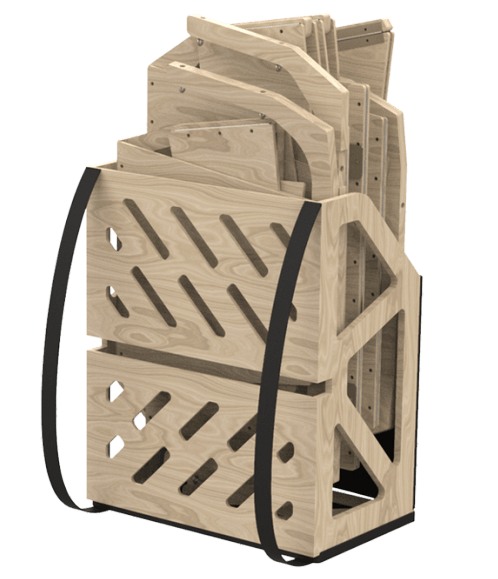
Though not overly long, it’s stable, sturdy, and comfortable for you to use for a long day of fishing. It’s even got a built-in skeg to make handling a breeze!
Best Tandem: ORU Kayak Haven TT
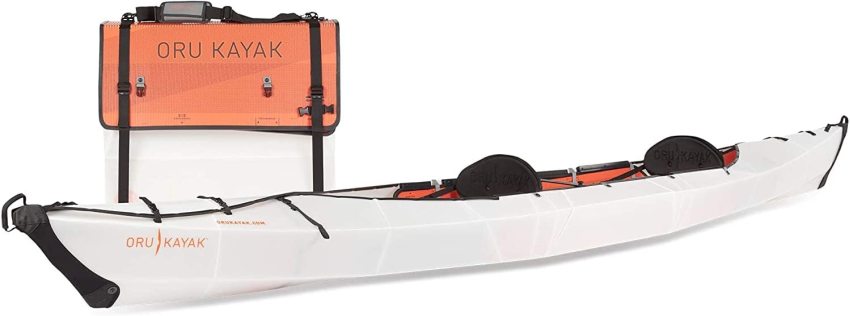
Length: 16’1″ (490.2 cm)
Beam Width: 33″ (83.8.cm)
Weight: 41 lbs. (18.6 kg)
Weight Capacity: 500 lbs. (226.8 kg)
If you’re going to paddle as a couple, or you want to take a child or oversized pet with you, ORU’s tandem kayak is definitely your best choice. Though it’s designed to accommodate two seats (with plenty of legroom for both paddlers) and two paddlers weighing up to 500 pounds total, it can also be used as a solo kayak. At over 16 feet long and 41 pounds, it’s a folding kayak built for use in all but the choppiest waters.
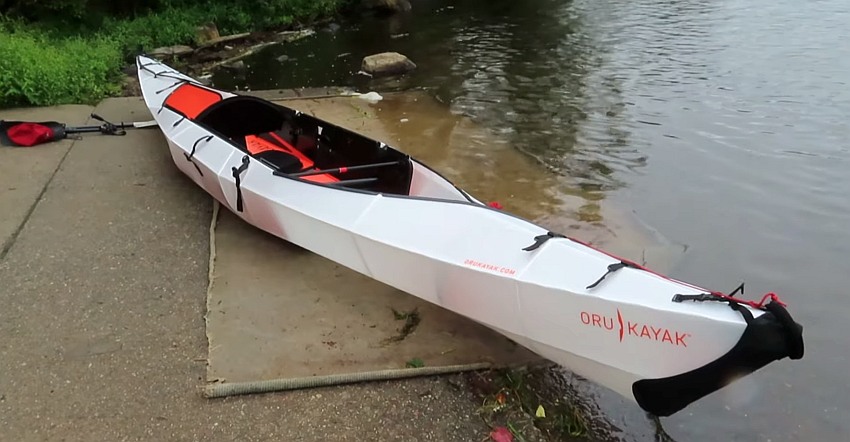
The kayak can even be used as a fishing platform. It’s stable and sturdy enough that you can fish standing up. Plus, it’s got a universal rail track system that is compatible with fishing accessories and has enough space to store your gear.
Like all ORU kayaks, the Haven TT is built from 5 mm double-layered, custom-extruded polypropylene that includes UV resistance that will keep it in great shape for 10+ years of regular use. You’ll find it’s one of the toughest, most reliable kayaks you’ll ever own—and that includes hard-shell kayaks.
Fastest: ORU Kayak Coast XT

Length: 16’2″ (492.7 cm)
Beam Width: 25″ (63.5 cm)
Weight: 32 lbs. (14.5 kg)
Weight Capacity: 400 lbs. (181.4 kg)
For those long-haul adventures across the Great Lakes or the open sea, the Coast XT by ORU Kayaks is a game-changer.
At a little over 16 feet long, it’s built like a touring kayak and can manage some spectacular speeds, slicing through waves and ocean currents like a dagger. It definitely emphasizes higher secondary stability, giving you great control over the kayak even when the swells are high or the wind is up.
Thanks to its 400-pound weight capacity, you can haul all the supplies and gear necessary for a multi-day trip, and the 180-liter storage capacity gives you plenty of room to store everything out of the way of your feet.
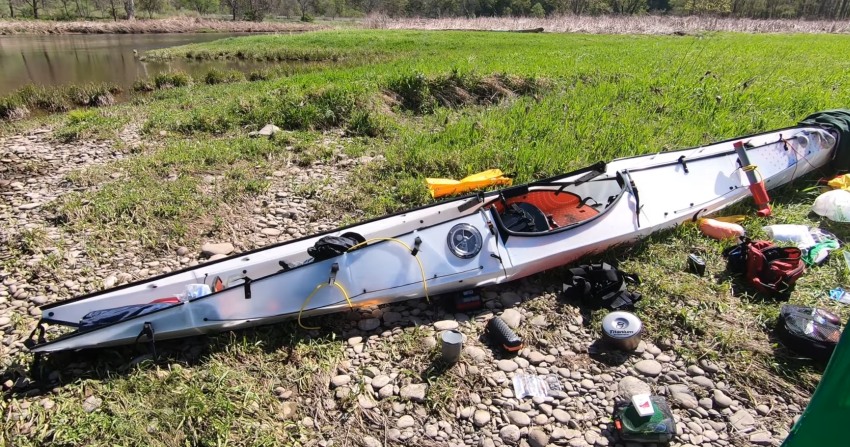
The enclosed cockpit is compatible with pretty much any universal spray skirt, giving you an easy way to keep the water out of your kayak even in a downpour or cutting through sea spray. The kayak’s hull is that ultra-tough 5 mm double-layered, custom-extruded polypropylene that makes ORU such a durable choice, capable of withstanding impacts, abrasions, and punctures like a beast.
Set up time on this kayak is a little longer—closer to 15 minutes—but once you’ve got it unfolded and secured, you’ll find it handles as well as any hard-shell touring kayak.
Most Portable: PAKAYAK Bluefin 142
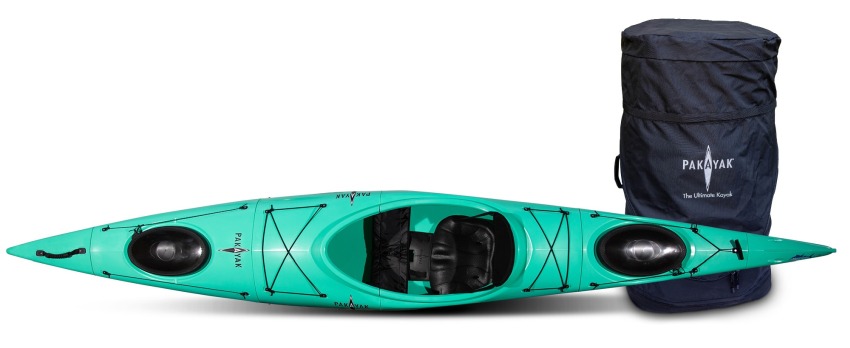
Length: 14’2″ (431.8 cm)
Beam Width: 24″ (61 cm)
Weight: 59 lbs. (26.7 kg)
Weight Capacity: 300 lbs. (136 kg)
This isn’t strictly a folding kayak; technically, it would be considered a nesting kayak. What that means is that the six modular sections can be disassembled and fit into the provided wheeled bag. It’s as good as a folding kayak, but with a design that offers a different sort of sturdiness (no creases, only joints connected by clamps and protected by watertight gaskets).
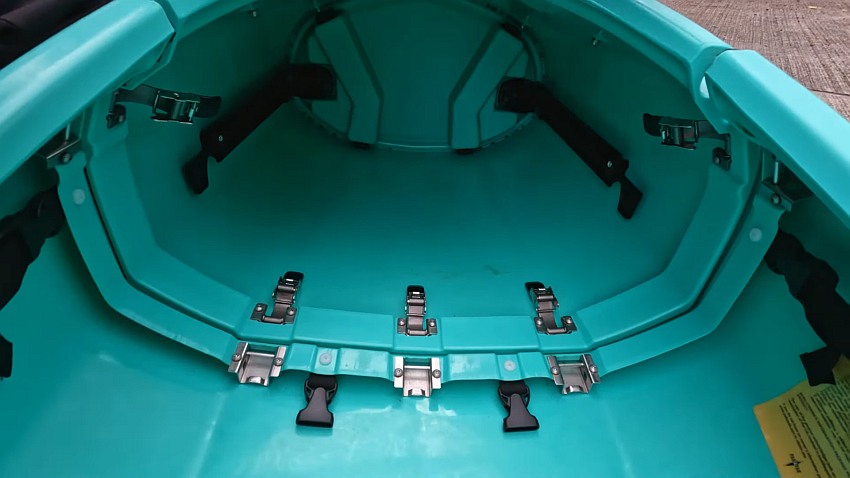
Once assembled, you’ll find it’s one of the best-performing open-water kayaks on our list, capable of handling fast-moving rivers, choppy lakes, and sea swells. At over 14 feet long, it’s sleek and will slice through the water at high speeds, but offers excellent stability so you never have to worry about capsizing.
It’s definitely one of the heavier kayaks on our list (59 pounds when packed down), but the 42-inch wheeled bag makes it incredibly easy to take with you everywhere you go. In fact, it’s the best choice for getting to your paddling destination whether you’re walking, riding the bus, or hopping a cab. Just wheel the bag with you to the water’s edge, unpack, and assemble (in 5 minutes), then you’re ready to hit the water.
Best Budget: TUCKTEC Folding Kayak
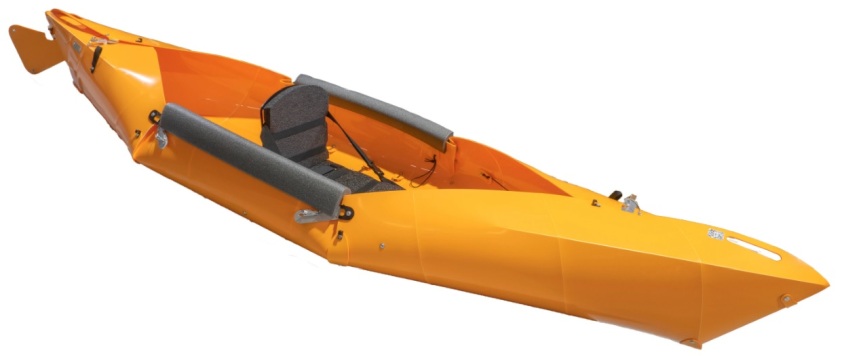
Length: 9’8″ (294.6 cm)
Beam Width: 31″ (78.7 cm)
Weight: 28 lbs. (12.7 kg)
Weight Capacity: 300 lbs. (136 kg)
For those who want an inexpensive option, the TUCKTEC Folding Kayaks are a great option to consider. Though not quite as tough as some of the others on this list, it’s still a good budget-friendly choice that will be right at home on flat lakes and slow-moving rivers. Heck, experienced paddlers may even be able to take it out onto a bay on a calm day.
At 28 pounds, this is one of the lightest kayaks on our list. However, it only has a 300-pound weight capacity and a fairly small cockpit, so it’s better off for “average-sized” paddlers.
It’s U.S. Coast Guard approved and rated for “thousands of folds” (number unspecified), and once you master the process, you’ll find it’s assembled in a matter of 2-4 minutes.
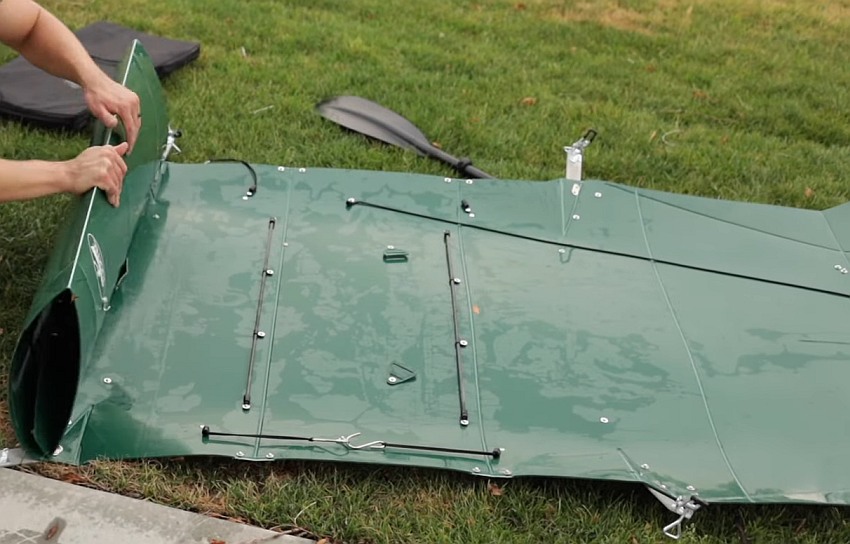
The solid plastic sheet will withstand repeated abrasions and impacts, and according to the manufacturer, it can handle the same abuse as a hard-shell kayak. Though not the fastest, sleekest, or most responsive, it’s definitely a good option for anyone who wants an affordable folding kayak.
A Complete Guide to Folding Kayaks
Now we’re going to take a deep dive into everything you need to know about folding kayaks. And trust me, there’s a lot!
Understanding what makes folding kayaks useful, what goes into building them, and how they’re designed for maximum efficiency will make the shopping process a whole lot easier.
Plus, you’ll have an easier time understanding the various factors to consider when buying a folding kayak.
Let’s start off with the basics…
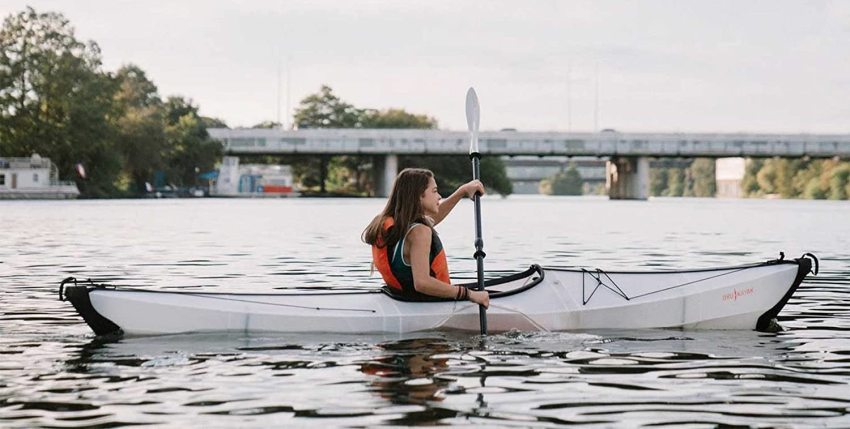
What are Folding Kayaks?
Folding kayaks are exactly what they sound like: a kayak designed to fold up.
There are three basic types of folding kayaks:
Inflatable Kayaks
Inflatable kayaks are technically folding kayaks in the sense that the inflatable material (often some variation of PVC) can, when deflated, be folded down small enough to pack into a bag. However, they have to be inflated to be useful, and must be deflated in order to fold down small.
We’ve got a separate article talking about the best inflatable kayaks (of which there are many), so we won’t be discussing that type of folding kayak in this article.
Frame Kayaks
Frame kayaks are an interesting design. Typically, they feature a frame (made of aluminum or wood) over which a “skin” or “shell” made from waterproof material is stretched to create the kayak.
These frames are generally designed to fold down, or may even disassemble fully. Some will include inflatable options, or some inflatable may feature integrated frames that create greater stability in the kayak’s body without adding too much weight.
Frame kayaks are a good option, but they’re not the “best” of the folding kayaks.
Origami Kayaks
Origami kayaks are the latest-and-greatest innovation in folding kayak technology.
As their name suggests, they’re designed to fold and unfold like origami, pre-folded with creases at just the right spots to allow for easy folding without compromising the strength and integrity of the kayak’s hull.
These are the kayaks that we’ll be mostly focusing on in this article, as they are the best option for folding kayak—not just because they use tough materials, but because they have a longer lifespan than most other folding and inflatable kayaks.
Folding Kayak Materials
Folding kayaks are made using some form of plastic—usually, a heavy-duty waterproof and impact-resistant plastic like polypropylene.
Some brands, like ORU, go a step farther than just a single solid sheet of plastic, and use multi-layered corrugated plastic to add extra durability and strength to the hull of their folding kayak.
Plastic tends to be a bit heavier than the PVC and synthetic materials used for inflatable kayaks, but as a trade-off, is much sturdier and less likely to be damaged—not only during kayaking, but also while folding/unfolding, transporting, and storing.
However, there is one downside: plastic (including propylene) is easily damaged by UV radiation. Over time, with regular exposure to sunlight, the material of your folding kayak will likely degrade, fade, lose color, grow brittle, and become more vulnerable to damage.
Which is why some companies add extra UV protection into the materials used for their kayak. As you’ll see by our “Factors to Consider” section below, this is definitely a crucial element to look for when shopping for a kayak, one that will extend its lifespan significantly and protect your investment.
Pros and Cons of Folding Kayaks
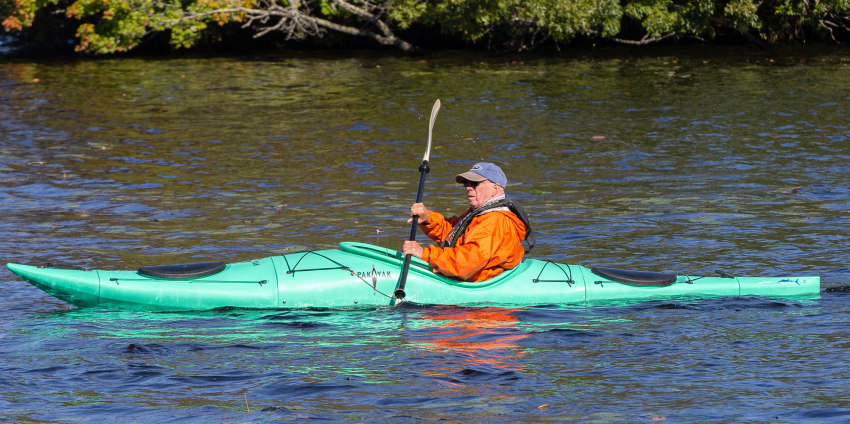
Why should you consider a folding kayak instead of a standard hard-shell or an inflatable kayak? Here is a quick look at some of the biggest pros and cons:
Folding v. Hard-Shell Kayaks
Pros:
- Far more portable; easier to transport and store
- Lightweight so anyone can carry it
- Great for anyone who lives in a small apartment or doesn’t have space to store a full-sized kayak
- No need for a roof rack or a kayak trailer
Cons:
- Not quite as versatile
- Not as sturdy or long-lasting
- More expensive
- Handling/tracking/steering isn’t quite as good
Folding v. Inflatable Kayaks
Pros:
- No need to pump or deflate anything
- Much faster to fold and unfold a kayak than inflate and deflate it
- More compact when packed
- Tool-free assembly is a breeze
- Sit deeper in the water, so handle/steer/track better
Cons:
- Plastic is heavier than PVC or other materials used for inflatable kayaks
- Significantly more expensive
- Will usually require more maintenance and care
As you can see, there are a lot of reasons to consider a folding kayak instead of a hard-shell or inflatable, but there are a few drawbacks you need to understand, too. Keep these in mind when shopping around!
Are Folding Kayaks Easy to Assemble?
The answer to this question depends on:
1) How good you are at following instructions
2) How good you are at building/assembling things yourself
Some people struggle with one or both of these, and find that they just can’t make heads or tails of the instructions provided to assemble—fold and unfold, in this case—their foldable kayak. For these people, the answer is “No, folding kayaks aren’t going to be easy to assemble.”
But for those who are used to following instructions (a.k.a., have built IKEA furniture) and are moderately good with their hands, foldable kayaks shouldn’t be too much trouble.
In my review of the ORU Bay ST, which I rank as the Best Recreational Folding Kayak, I talked a bit about assembly time.
Initially, when I first unpacked the kayak and set about unfolding it (using the video and the provided written instructions), it took me about 25 minutes to transform it from packed-in-the-box to ready-to-paddle. That’s definitely a LOT longer than it would have taken me to fill an inflatable kayak.
Re-folding it (disassembly) on my first try, however, was an absolute breeze. Even though it was my first time following the instructions, I had a pretty clear understanding of the steps I took to unfold (assemble) it, so I just followed those steps in reverse.
Seriously, 5 minutes was all it took for me to fold it up and get it ready for transportation.
On my second attempt, the unfolding process was much simpler and easier to go through because I’d figured it all out the first time. It was under 10 minutes for unfolding (assembly) and less than 5 minutes for folding (disassembly).
So though the initial assembly may be a bit tricky, once you learn the instructions, it becomes a beautifully easy task that you can repeat with minimal effort, frustration, and hassle.
For this alone, I can’t recommend folding kayaks strongly enough—I far prefer them to your average inflatable kayak.
Factors to Consider When Shopping for Folding Kayaks
If everything you’ve read above has convinced you to give folding kayaks a try, then it’s time to look at all the crucial factors you need to consider before making your purchase.
Take it from me: buying the wrong kayak can lead to a whole lot of discomfort, not to mention higher risk of capsizing, exponentially greater effort required to paddle, and a lot of money wasted.
Let’s dive in and find out everything you need to factor into your decision to make sure you get the best foldable kayak for you…
Purpose
You wouldn’t take a touring kayak down a stretch of Class IV whitewater rapids, any more than you’d take a whitewater kayak out onto the ocean for a two-day expedition.
Buying the right kayak for the right purpose is crucial—and even more so when you’re talking about folding kayaks.
Hard-shell kayaks tend to be a bit more versatile, but folding kayaks are typically purpose-built. For example, look at all of the various kayaks ORU offers:
- Beach LT is built like a recreational kayak, ideal for flat, calm water with excellent primary stability
- Bay ST is built to be fast, sporty, and with higher secondary stability that makes it better-suited to coastlines and the ocean waves
- Coast XT is designed like a touring kayak, longer, more stable, and capable of handling the open seas
- Lake is lightweight and ultra-portable, great for kids and adults both, but only on flat waters
It’s important that you consider where you’ll be paddling—fast-flowing rivers, slow-moving lakes, wind-tossed oceans, etc.—and find the folding kayak built for that specific activity.
It will make a huge difference both in performance and comfort!
Weight Capacity
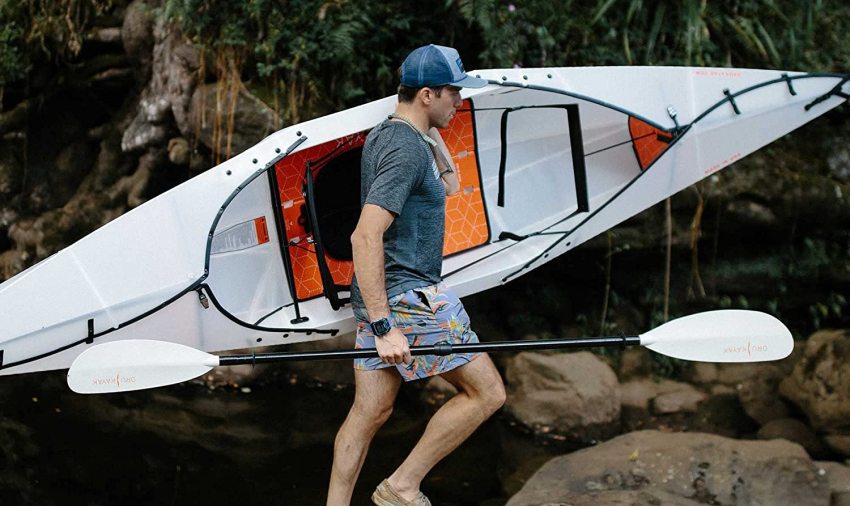
For the “average” paddler, this isn’t a big deal.
Most kayaks will easily accommodate your “standard-sized” kayaker—someone under 6 feet tall, weighing less than 200 pounds. But when you get to bigger kayakers (like me, at 6’6” and 250 pounds), then things like cockpit size (see below) and weight capacity become a matter to take seriously.
With inflatable kayaks, you typically have a much higher weight capacity than hard-shell kayaks because inflatables are filled with air, and thus have a significantly greater buoyancy. Folding kayaks are more akin to hard-shell kayaks in this case—and will usually have a weight capacity to match.
Remember: the weight capacity needs to accommodate not only you, the paddler, with your specific weight, but also the weight of your gear.
If you’re lake paddling for a few hours, there’s not a whole lot of extra weight capacity needed. But if, on the other hand, you’re headed out to sea or downriver on a multi-day trip, you’ll want to make sure to find a folding kayak with the weight capacity to accommodate you and all the gear you need to cart along with you.
Cockpit Size
Again, this might not feel like a problem for more “average-sized” people, but for us very large and very small people, it can mean all the difference.
For example, in my review of the ORU Bay ST, the enclosed cockpit (designed to protect paddlers against ocean swells and spray) was just too small to accommodate my 6’6” frame. My 6’3” brother-in-law, on the other hand, found it a far more comfortable fit.
Most folding kayaks are of the sit-in variety rather than the sit-on-top. This means there is an enclosed cockpit, one you should make sure is sized right for you.
And by “sized right”, I mean you should be able to easily get in and out without banging your knees on the edge or feeling trapped. Trust me, if you have to bail in an emergency situation, freedom of movement is everything.
Passengers
Buy the kayak that will accommodate the people who will be using it.
If you’re a solo paddler, you’ve really only got to factor in the kayak that works best and is sized right for you. But if you plan on taking more people along with you, that’s when things get interesting.
There are tandem folding kayaks (as you’ll see on our list below), some of which can be transformed to use both for solo and tandem use. These are great if you plan on bringing a fellow adult with you along for the ride.
Or, if you’re paddling with a kid or pet, it may be a good idea to consider a kayak with a more open cockpit and, possibly, space for another paddler.
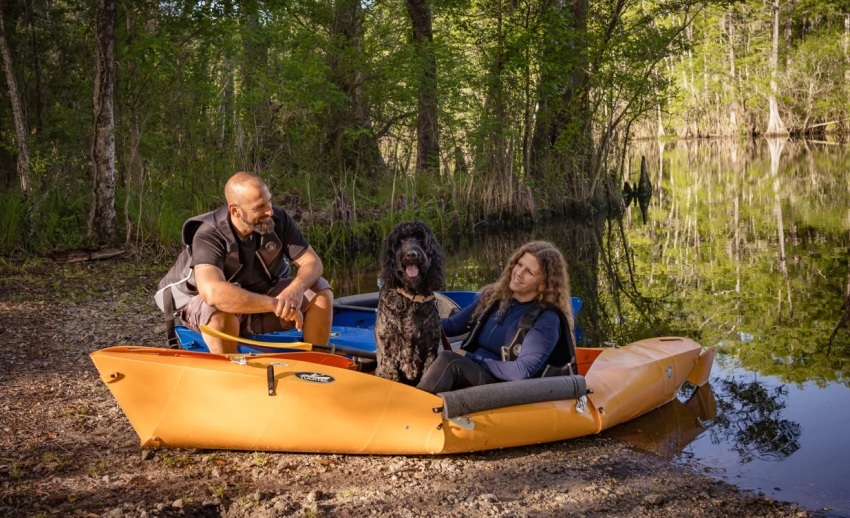
That way, your child can paddle or rest as they want, and will be able to jump into the water to swim around and cool off. For pets, a kayak with high primary stability will make it easy for them to get in and out of the water, and a larger cockpit will give them space to sit/lie down while you paddle.
Durability
Folding kayaks are tougher than inflatable kayaks but often less durable than hard-shell kayaks. That means it’s important to consider just how durable they are and look for the toughest, most resilient options around.
There are a few forms of durability you need to take into account:
UV Resistance
A well-built folding kayak will have integrated UV protection that keeps the plastic from being degraded, weakened, or deteriorated by the sunlight.
Remember: you’re going to be spending long hours under the bright sun, paddling around the lake, bay, or downriver. There has to be some form of UV protection or UV resistance incorporated into the kayak in order to keep it from being damaged.
Thankfully, most folding kayak manufacturers will tell you if they incorporate some measure of UV resistance into their kayaks, so it’s easy to tell at a glance just by reading the product page.
Puncture Resistance
Folding kayaks are made from tough plastic (polypropylene), which is far sturdier and at less risk of being punctured than the soft materials of inflatable kayaks (which use PVC or nylon).
However, there is still the chance that hitting some underwater obstacle—a sharp rock or log—will damage the hull. It’s worth reading reviews to make sure the folding kayak you’re considering is capable of withstanding direct impact that could pierce or puncture the hull.
Abrasion Resistance
Every time you beach your kayak, you scrape it across sand, rocks, coral, and other abrasive substances. If you ever paddle in water that’s too shallow or above an underwater obstacle, there’s a risk of abrading the bottom of the kayak.
Which makes it crucial to find a kayak that has natural abrasion resistance.
Kayaks with multi-layered hulls (such as the corrugated plastic used by ORU) will be far more abrasion-resistant than single-layered plastic hulls—and thus will be less prone to damage if you run aground or scrape over submerged objects.
Sturdy Components
Folding kayaks usually come with a variety of components: an integrated seat, bungee cord that makes for easy assembly, latches and locks to keep the hull in place, rubber coaming to protect against water seeping in, paddles, and more.
These components are, to put it frankly, the “weak spot” in the kayak’s design. As such, they’re the most likely to break or get damaged with repeated use.
It’s important to comb through reviews and see if any of the folding kayaks you’re considering have flaws, defects, or malfunctions with the various components that are required for assembly. That way, you can see what to do to avoid these problems, or be prepared to replace or fix the malfunctioning components yourself.
And, if there are any folding kayak components that are overly prone to breakage or defect, it may be a good indication to stay away from that particular folding kayak and look elsewhere for one with greater durability.
Portability
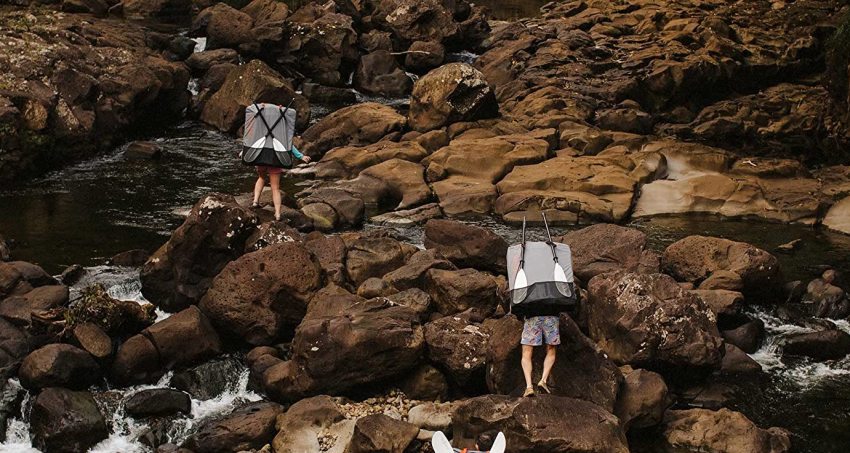
When talking about the portability of a folding kayak, there are two factors to evaluate:
Weight
Folding kayaks tend to be significantly lighter than hard-shell kayaks, but heavier than inflatables.
Typically, they’ll weigh in the 20 to 30-pound range, depending on the kayak’s length (which determines the amount of plastic used in its construction).
I’ve got no trouble hauling a full-sized folding kayak, but my wife (who barely clears 5’3”) is better suited to carrying a smaller, lighter kayak.
Buy a kayak you know you can carry—after all, the whole point of owning a folding kayak is being able to haul it around anywhere and everywhere.
Folded Size
When folded down (disassembled), you want a kayak that is ideally small enough to fit into the trunk of your car, a corner of your apartment, or somewhere out of the way of your garage.
Thankfully, most folding kayaks (like inflatable kayaks and paddleboards) will fold down to roughly the size of a small suitcase, easy to transport and store without taking up too much space.
Packability
How hard is the kayak to fold and unfold, to pack and unpack?
And no, I don’t mean on the first try. As you saw above, what took me 25 minutes on my first try was ultimately an under-10-minute assembly and a 5-minute disassembly.
It’s okay if the folding kayak is difficult to fold and unfold on your first few attempts, but if it’s continually a hassle or has too many moving parts that are easy to lose or hard to pack safely, it may be a good idea to look at another, more packing-friendly option.
Fold Cycles
This is an interesting one, a factor unique to origami folding kayaks.
As I explained above, these folding kayaks come with pre-folded creases that dictate exactly where and how to fold/unfold the hull.
No great surprise, these creases are the “weak spots” on the hull, the parts most likely to crack, weaken, and wear out over time.
This is why most folding kayak manufacturers will test the plastic to figure out how many times it can be folded or unfolded. This is what they call “fold cycles”—one unfold (assembly) and re-fold (disassembly) is one “cycle”.
You’ll find that most folding kayaks are built for between 10,000 and 20,000 fold cycles. The higher the number of fold cycles, the more durable the seams/creases will be, and the less likely the kayak is to break on you with years of folding and unfolding.
Seating
Always look at the seating to make sure it A) offers sufficient back support, and B) is comfortable enough for long hours of kayaking.
The sad truth is that most folding kayaks can’t really offer seating on par with the uber-comfortable and supportive seats integrated into top-of-the-line hard-shell kayaks. If this is a concern—if you, like me, have back problems—it may be one argument for opting for a standard kayak instead of a folding kayak.
Accessories
Most folding kayaks will come with the basic accessories: the seat and footrest, paddles, and the basic deck bungee cables to secure your gear. Some will even include storage space (though no watertight compartments) for extra gear.
If you’re an angler, you may want to look for a folding kayak that offers fishing rod holders—or, at least, has the capacity to add them on.
Price
Last but not least, it’s worth factoring in just how much the kayak will cost you to get out on the water.
As I mentioned above, inflatable kayaks are always the cheapest option, though not the most durable.
Hard-shell kayaks, interestingly enough, may end up costing you less than a folding kayak. This is especially true for lower-end fishing, recreational, and even touring kayaks.
Folding kayaks will usually be about on par with your average mid-range kayak, though they won’t offer as many features or as much versatility. What you’re paying for is the convenience and portability more than anything else.
Expect to spend at least $1,000 on a good folding kayak, though as you’ll see on our list below, there are a few more budget-friendly options to consider.
Folding Kayak FAQs
Folding kayaks are typically designed for between 10,000 and 20,000 “folding cycles”—the number of times it is unfolded and refolded.
Translating that into real numbers: 10,000 folding cycles = 500 kayaking trips per year x 20 years.
Definitely more than sturdy enough to last you for years to come!
If you live in an apartment, drive a small vehicle with no roof rack and no trailer hitch, have minimal storage space, or have to travel by public transportation to reach your paddling destinations, folding kayaks are certainly an excellent option. They’re portable, convenient, and lightweight.
Folding kayaks aren’t as buoyant as (air-filled) inflatable kayaks, but like hard-shell kayaks, the materials used in their construction have sufficient buoyancy that they won’t sink even when filled with water.
The plastic used for folding kayaks is light enough to float just below the surface, making it possible to right, re-mount, and drain the same way you would with any hard-shell kayak.
Hard-shell kayaks are definitely more durable than folding kayaks, but that’s really only a big issue in high-impact activities like whitewater kayaking. For your average lake, river, bay, or ocean kayaking trip, the durability of a folding kayak is more than enough to handle the paddling conditions.



